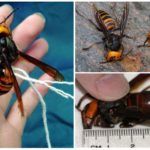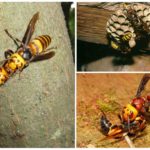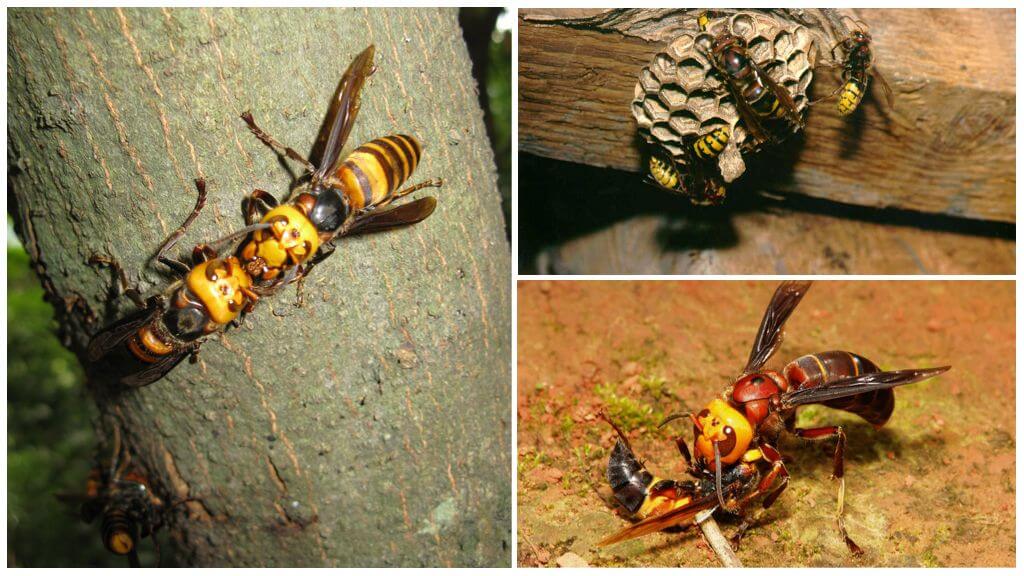Giant japanese hornet
Content
- Giant japanese hornet
- Giant japanese hornet
Insect features
The huge Japanese hornet, known as the "sparrow bee", does not at all resemble a friendly bird. Moreover, the stinging insect is very aggressive.
Vespa mandarinia japonica (giant Japanese hornet) differs from its counterparts not only in coloring, but also in its large size:
- It is an insect up to 5 cm, whose wingspan reaches 6-7 cm.
- Outwardly, the giant is very similar to the wasp: it has a segmented body with yellow-brown stripes, a black chest. On the head of a yellow-orange color there are two large eyes and three additional accessory eyes. Photos of the Japanese hornet presented below.
- Another characteristic feature of the insect are powerful jaws, with which the Japanese hornet is capable of harming an even larger adversary.
- The main weapon of the giant is a very long sting (more than 6 mm).With its help, the Japanese hornet deals a painful blow, letting in its sacrifice having a nerve-paralytic effect poison. Moreover, this body are exclusively females.
On a note!
The strongest poison of the giant can, even with a single bite, cause serious allergies, and some people develop anaphylactic shock. Consequences of mass attacks by representatives of this species can be various hemorrhages and tissue necrosis.
Lifestyle and nutrition of the Japanese giant
Each individual in the hive has its own responsibilities. The "leading position" is occupied by the queen uterus, which is the continuer of the gens. The delivery of food engaged in hornets workers. Going to find her, working individuals can travel several kilometers.
Food for hornet giant serves not only fruits and sugar-containing vegetables, but also insect pests of agricultural crops, as well as honey bees. Having found a beehive, the hornet marks it with an odorous liquid, which allows it to subsequently return to the find along with its brethren.During the attack, giants in the literal sense of the word dismember the body of their victims, seeking to extract valuable meat from them. Having settled with adult individuals, tyrants collect larvae and honey, which also serve them as food.
Interesting!
It takes no more than a minute for the Japanese hornet to exterminate up to 4 dozen bees. For 3 hours, 3 dozen individuals can destroy the entire bee family.
Where does the giant hornet live
By the name of the insect, it becomes clear that Japan is the birthplace of the huge Japanese hornet. Outside this country, the giant can only be found in the southern part of Sakhalin Island. When choosing a habitat, insects prefer quiet, cozy places, building nests in hollows and on tree branches, in rock crevices and under the eaves of buildings. The cocoon of the giant hornet is very similar to vespiary, it differs from the latter only in large dimensions.
How to multiply
In the spring, the fertilized female builds a nest from the bark of the branches, which she crushes with her powerful jaws. The queen uterus weaves the wood particles with the secret of the salivary glands, as a result of which the composition takes the form of coarse paper.
Of the three hundred eggs laid by the female in 7-10 days the larvae appear. After three molts, they pupate. A month later, a young hornet comes out of the pupa. He can not only find food for himself, but also take care of the emerged larvae.
Interesting!
In unfertilized eggs, only male individuals develop. Future female protagonists occupy more spacious and comfortable cells.
With the increase in the number of individuals in the family, the size of the nest increases. Juveniles begin to mate, future queens of the uterus go in search of a favorable place to build a nest, and males die as the cold approaches. With the arrival of heat, the females wake up and start building a new shelter.
Bite symptoms
The bite of the Japanese hornet is accompanied by:
- severe pain;
- the occurrence of extensive redness and swelling in the area of damage to the skin;
- heart palpitations and headache;
- high body temperature and swollen lymph nodes;
- shortness of breath and nausea.
Giant hornets are able to repeatedly sting their prey and for this they do not necessarily sit on the skin.
Getting histamine (an allergic compound) into a person’s blood is especially dangerous for hypersensitive people. Therefore, they urgently need medical assistance.
Important!
Pre-medical actions consist in applying a cold compress to the bite site and taking an antihistamine.
What you should know
To avoid becoming a victim of the Japanese hornet, you must observe basic precautions:
- when meeting with an insect, one should not swing his arms and make sharp movements, trying to drive him away from himself;
- no need to try to catch or kill the Japanese hornet, since after that the offender is unlikely to be able to avoid the attack;
- in no case should not destroy the nest of dangerous insects.









